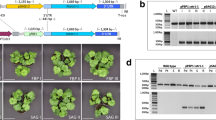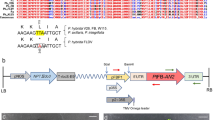Abstract
Flowers of the complex orchid hybrid Burrageara ‘Stefan Isler Lava Flow’ had been shown previously to react sensitively to ethylene. Via Agrobacterium tumefaciens, the mutant ethylene receptor ETHYLENE RESPONSE 1 (etr1-1) from Arabidopsis thaliana under the control of the flower-specific promoter FLOWER BINDING PROTEIN 1 (fbp1) from Petunia hybrida was transferred to Burrageara. One single-copy event was analyzed in this study aiming to investigate the expression of the fbp1::etr1-1 transgene in different plant and flower organs by quantitative RT-PCR and the reaction of flowers and inflorescences to ethylene. It was shown that the heterologous promoter led to high expression levels in the perianth of the orchid flowers compared to low levels in leaves and roots. The expression shift to the first whorl (sepals) described here corresponds to extended expression of endogenous B class MADS box homeotic genes in orchids in general. The transgenic plants grew and developed similar to the wild-type plants, except for slightly faster rooting in vitro and smaller flowers. Flower longevity was improved by 7 days in 10 ppm ethylene. Moreover, bud drop starting at day 5 of incubation of inflorescences in 10 ppm ethylene in the wild-type was efficiently prevented for at least 19 days in the fbp1::etr1-1 transgenic plants. The function of the tissue-specific promoter fbp1 and the mutant receptor etr1-1 was shown for the first time in a monocotyledonous plant.





Similar content being viewed by others
References
Abeles FB, Morgan PW, Saltveit ME (1992) Ethylene in plant biology. Academic Press, New York, p 414
Aceto S, Gaudio L (2011) The MADS and the beauty: genes involved in the development of orchid flowers. Curr Genom 12:342–356
Angenent GC, Busscher M, Franken J, Mol JNM, van Tunen AJ (1992) Differential expression of two MADS box genes in wild-type and mutant petunia flowers. Plant Cell 4:983–993
Angenent GC, Franken J, Busscher M, Colombo L, van Tunen AJ (1993) Petal and stamen formation in petunia is regulated by the homeotic gene fbp1. Plant J 4:101–112
Bleecker AB, Patterson SE (1997) Last exit: senescence, abscission, and meristem arrest in Arabidopsis. Plant Cell 9:1169–1179
Boase MR, Harriman RW, Smith FD, Deroles SC (2012) Herbicide-resistant, transgenic zonal pelargoniums produced by step-down glyphosate selection and plantlet recovery in the presence of aromatic amino acids. In Vitro Cell Dev Biol Plant 48:313–323
Bovy AG, Angenent GC, Dons HJM, van Altvorst AC (1999) Heterologous expression of the Arabidopsis etr1-1 allele inhibits the senescence of carnation flowers. Mol Breed 5:301–308
Brown KM (1997) Ethylene and abscission. Physiol Plant 100:567–576
Bunya-aticharta K, Ketsa S, van Doorn WG (2006) High floral bud abscission and lack of open flower abscission in Dendrobium cv. Miss Teen: rapid reduction of ethylene sensitivity in the abscission zone. Funct Plant Biol 33:539–546
Bunya-aticharta K, Ketsa S, van Doorn WG (2011) Ethylene-sensitive and ethylene-insensitive abscission in Dendrobium: correlation with polygalacturonase activity. Postharvest Biol Technol 60:71–74
Chang C, Kwok SF, Bleecker AB, Meyerowitz EM (1993) Arabidopsis ethylene-response gene ETR1: similarity of product to two-component regulators. Science 262:539–544
Chen J-F, Gallie DR (2010) Analysis of the functional conservation of ethylene receptors between maize and Arabidopsis. Plant Mol Biol 74:405–421
Clark DG, Gubrium EK, Barrett JE, Nell TA, Klee HJ (1999) Root formation in ethylene-insensitive plants. Plant Physiol 121:53–59
Debener T, Winkelmann T (2010) Ornamentals. In: Kempken F, Jung C (eds) Genetic modification of plants, Biotechnology in agriculture and forestry. vol 64. Springer, Berlin, pp 369–391
Gamble RL, Qu X, Schaller GE (2002) Mutational analysis of the ethylene receptor ETR1. Role of the histidine kinase domain in dominant ethylene insensitivity. Plant Physiol 128:1428–1438
Guo H, Ecker JR (2004) The ethylene signaling pathway: new insights. Curr Opin Plant Biol 7:40–49
Hall BP, Shakeel SN, Schaller E (2007) Ethylene receptors: ethylene perception and signal transduction. J Plant Growth Regul 26:118–130
Han BH, Suh EJ, Lee SY, Shin HK, Lim YP (2007) Selection of non-branching lines induced by introducing Ls-like cDNA into Chrysanthemum (Dendranthema x grandiflorum (Ramat.) Kitamura) “Shuho-no-chikara”. Sci Hortic 115:70–75
Hew CS, Clifford PE (1993) Plant growth regulators and the orchid cut-flower industry. Plant Growth Regul 13:231–239
Hou CJ, Yang CH (2009) Functional analysis of FT and TFL1 orthologs from orchid (Oncidium Gower Ramsey) that regulate the vegetative to reproductive transition. Plant Cell Physiol 50:1544–1557
Huang CC, Paull RE (2009) The responses of Oncidium cut flowers to ethylene and 1-MCP. J Taiwan Agric Res 58:1–6
Huang WF, Huang PL, Do YY (2007) Ethylene receptor transcript accumulation patterns during flower senescence in Oncidium ‘Gower Ramsey’ as affected by exogenous ethylene and pollinia cap dislodgment. Postharvest Biol Technol 44:87–94
Immink RGH, Ferrario S, Busscher-Lange J, Kooiker M, Busscher M, Angenent GC (2003) Analysis of the petunia MADS-box transcription factor family. Mol Gen Genom 268:598–606
Kim JH, Botella JR (2004) Etr1-1 gene expression alters regeneration patterns in transgenic lettuce stimulating root formation. Plant Cell Tiss Organ Cult 78:69–73
Langston BJ, Bai S, Jones ML (2005) Increases in DNA fragmentation and induction of a senescence-specific nuclease are delayed during corolla senescence in ethylene. J Exp Bot 56:15–23
Liu Q, Wen C-K (2012) Arabidopsis ETR1 and ERS1 differentially repress the ethylene response in combination with other ethylene receptor genes. Plant Physiol 158:1193–1207
Livak KJ, Schmittgen TD (2001) A quantitative assay for measuring mRNA decapping by splinted ligation reverse transcription polymerase chain reaction: qSL-RT-PCR. RNA 17:535–543
Mapeli AM, De Oliveira LS, Megguer CA, Barbosa JG, Barros RS, Finger FL (2009) Characterisation of respiration, ethylene production, and carbohydrate contents during flower opening in Epidendrum ibaguense. J Hort Sci Biotechnol 84:609–612
Merchante C, Alonso JM, Stepanova AN (2013) Ethylene signaling: simple ligand, complex regulation. Curr Opin Plant Biol 16:554–560
Mibus H, Heckl D, Serek M (2011) Cloning and characterisation of three APETALA1 homologous genes in different flower types of Rosa hybrida L. J Plant Growth Regul 30:272–285
Mondragon-Palomino M, Theißen G (2009) Why are orchid flowers so diverse? Reduction of evolutionary constraints by paralogues of class B floral homeotic genes. Ann Bot 104:583–594
Murashige T, Skoog F (1962) A revised medium for rapid growth and bioassays with tobacco tissue cultures. Physiol Plant 15:473–497
Patterson SE, Bleecker AB (2004) Ethylene-dependent and—independent processes associated with floral organ abscission in Arabidopsis. Plant Physiol 134:194–203
Raffeiner B, Serek M, Winkelmann T (2009a) Agrobacterium tumefaciens mediated transformation of Oncidium and Odontoglossum orchid species with the ethylene receptor mutant gene etr1-1. Plant Cell Tiss Organ Cult 98:125–134
Raffeiner B, Serek M, Winkelmann T (2009b) 1-Methylcyclopropene inhibits ethylene effects in cut inflorescences and potted plants of Oncidium and Odontoglossum orchid species. Europ J Hortic Sci 74:10–15
Raffeiner B, Serek M, Winkelmann T (2010) Establishment and optimization of an efficient in vitro regeneration system of Oncidium, Wilsonara, Odontocidium and Vuylstekeara. Acta Hortic 878:445–452
Rattanawisalanon C, Ketsa S, van Doorn WG (2003) Effect of aminooxyacetic acid and sugars on the vase life of Dendrobium flowers. Postharvest Biol Technol 29:93–100
Sanikhani M, Mibus H, Stummann BM, Serek M (2008) Kalanchoë blossfeldiana plants expressing Arabidopsis etr1-1 allele show reduced ethylene sensitivity. Plant Cell Rep 27:729–737
Shakeel SN, Wang X, Binder BM, Schaller GE (2013) Mechanisms of signal transduction by ethylene: overlapping and nonoverlapping signalling roles in a receptor family. AoB Plants 5:plt010
Shaw JF, Chen HH, Tsai MF, Kuo CI, Huang LC (2002) Extended flower longevity of Petunia hybrida plants transformed with boers, a mutated ERS gene of Brassica olercea. Mol Breed 9:211–216
Sriskandarajah S, Mibus H, Serek M (2007) Transgenic Campanula carpatica plants with reduced ethylene sensitivity showing specific expression of etr1-1 in flowers and buds. Plant Cell Rep 26:805–813
Sun Y, Christensen B, Liu F, HQ W, Mueller R (2009) Effects of ethylene and 1-MCP (1-methylcyclopropene) on bud and flower drop in mini Phalaenopsis cultivars. Plant Growth Regul 59:83–91
Tanase K, Aida R, Yamaguchi H, Tanikawa N, Nagata M, Onozaki T, Ichimura K (2011) Heterologous expression of a mutated carnation ethylene receptor gene, Dc-ETR1nr, suppresses petal abscission and autocatalytic ethylene production in transgenic Torenia fournieri Lind. J Jpn Soc Hortic Sci 80:113–120
Tsai WC, Hsiao YY, Pan ZJ, Kuoh CS, Chen WH, Chen HH (2008) The role of ethylene in orchid ovule development. Plant Sci 175:98–105
van Doorn WG, Woltering EJ (2008) Physiology and molecular biology of petal senescence. J Exp Bot 59:453–480
Wang H, Stier G, Lin J, Liu G, Zhang Z, Chang Y, Reid MR, Jiang CZ (2013) Transcriptome changes associated with delayed flower senescence on transgenic petunia by inducing expression of etr1-1, a mutant ethylene receptor. PLOS one 8(7):e65800
Wilkinson JQ, Lanahan MB, Clark DG, Bleecker AB, Chang C, Meyerowitz EM, Klee HJ (1997) A dominant mutant receptor from Arabidopsis confers ethylene insensitivity in heterologous plants. Nat Biotechnol 15:444–447
Woltering EJ, van Doorn WG (1988) Role of ethylene in senescence of petals—morphological and taxonomical relationships. J Exp Bot 39:1605–1616
Zahn LM, Leebens-Mack J, De Pamphilis CW, Ma H, Theissen G (2005) To B or not to B a flower: the role of DEFICIENS and GLOBOSA orthologs in the evolution of the angiosperms. J Hered 96:225–240
Acknowledgments
The authors thank Ewa Schneider, Bärbel Ernst, Peter Pietrzyk, and Annette Steding for their excellent technical assistance.
Author information
Authors and Affiliations
Corresponding author
Electronic supplementary material
Below is the link to the electronic supplementary material.
Rights and permissions
About this article
Cite this article
Winkelmann, T., Warwas, M., Raffeiner, B. et al. Improved Postharvest Quality of Inflorescences of fbp1::etr1-1 Transgenic Burrageara ‘Stefan Isler Lava Flow’. J Plant Growth Regul 35, 390–400 (2016). https://doi.org/10.1007/s00344-015-9545-2
Received:
Accepted:
Published:
Issue Date:
DOI: https://doi.org/10.1007/s00344-015-9545-2




